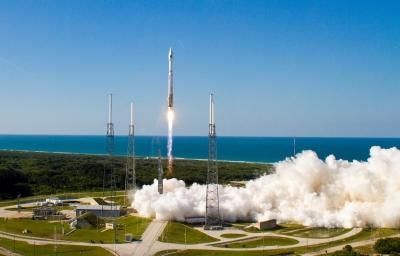Fri, May 17, 2013
United Launch Alliance Launches 70th Successful Mission In 77 Months
The fourth Global Positioning System (GPS) IIF-4 satellite for the U.S. Air Force was boosted into orbit at 1738 EDT Wednesday from Space Launch Complex-41 by a United Launch Alliance (ULA) Atlas V rocket.

"The ULA team is honored to place another next-generation GPS satellite on orbit for our U.S. Air Force customer," said Jim Sponnick, ULA vice president, Mission Operations. "Today's successful delivery of the GPS IIF-4 mission represents the 70th launch success in the 77 months since ULA was formed – an accomplishment made possible by seamless integration of the customer and industry team; reliable production and launch operation processes; and a one-launch-at-a-time focus on mission success for these critical space assets."
This mission was launched aboard an Atlas V 401 Evolved Expendable Launch Vehicle (EELV), which includes a 4-meter diameter payload fairing. The booster for this mission was powered by the RD AMROSS RD-180 engine and the Centaur upper stage was powered by a single Pratt & Whitney Rocketdyne RL-10A engine.
"The ULA team has launched 51 GPS missions on Delta II and Delta IV vehicles and this mission marks the first operational GPS mission launched on an Atlas V launch vehicle," said Sponnick. "Successfully and efficiently integrating and launching these satellites on both EELV launch systems provides operational flexibility and in the future, capabilities such as dual launch will provide even greater flexibility and also enable lower launch costs for our customers."
GPS IIF-4 is the fourth in a series of next generation GPS satellites and will join a worldwide timing and navigation system utilizing 24 satellites in six different planes, with a minimum of four satellites per plane positioned in orbit approximately 11,000 miles above the Earth's surface. The GPS IIF series provides improved accuracy and enhanced performance for GPS users.
The EELV program was established by the United States Air Force to provide assured access to space for Department of Defense and other government payloads. The commercially developed EELV Program supports the full range of government mission requirements, while delivering on schedule and providing significant cost savings over the heritage launch systems.
(Image provided by the USAF)
More News
Takeoff Roll The process whereby an aircraft is aligned with the runway centerline and the aircraft is moving with the intent to take off. For helicopters, this pertains to the act>[...]
“We’re proud of the hard work that went into receiving this validation, and it will be a welcome relief to our customers in the European Union. We couldn’t be mor>[...]
"Aircraft Spruce is pleased to announce the acquisition of the parts distribution operations of Wag-Aero. Wag-Aero was founded in the 1960’s by Dick and Bobbie Wagner in the >[...]
IDENT Feature The special feature in the Air Traffic Control Radar Beacon System (ATCRBS) equipment. It is used to immediately distinguish one displayed beacon target from other be>[...]
Aero Linx: Pararescue Air Force Pararescuemen, also known as PJs, are the only DoD elite combat forces specifically organized, trained, equipped, and postured to conduct full spect>[...]
 ANN's Daily Aero-Term (05.10.24): Takeoff Roll
ANN's Daily Aero-Term (05.10.24): Takeoff Roll Aero-News: Quote of the Day (05.10.24)
Aero-News: Quote of the Day (05.10.24) Aero-News: Quote of the Day (05.11.24)
Aero-News: Quote of the Day (05.11.24) ANN's Daily Aero-Term (05.11.24): IDENT Feature
ANN's Daily Aero-Term (05.11.24): IDENT Feature ANN's Daily Aero-Linx (05.11.24)
ANN's Daily Aero-Linx (05.11.24)



